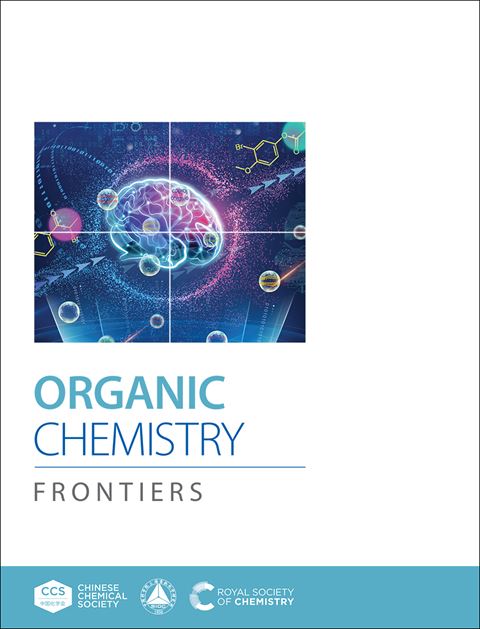A main-chain [6]rotaxane: from synthesis to multi-stimuli-responsive motions
IF 4.7
1区 化学
Q1 CHEMISTRY, ORGANIC
引用次数: 0
Abstract
The synthesis of higher order oligo[n]rotaxanes (usually n ≥ 3) featuring multi-stimuli responsive motions at the molecular level is critical for advancing artificial molecular machines and smart materials, yet achieving this goal remains a significant challenge. Herein, a main-chain [6]rotaxane and control [n]rotaxanes (n= 2, 3, and 4) were constructed with the assistance of templation by bipyridinium- or dialkylammonium-threaded two dimensional hydrogen-bonded (H-bonded) azo-macrocycles via Cu-mediated azide-alkyne cycloaddition reaction. The [6]rotaxane exhibits reversible multi-stimuli responsive motions triggered by acid-base reactions, solvent polarity changes, and light irradiation. Notably, three macrocycles (one ring A component and two ring B components), which are compactly stacked at the bipyridinium (BP2+) station owing to the large π-surface, act as a masked binding site to facilitate shuttling of the remaining two macrocycles (ring C components) driven by cooperative π-π stacking interactions. Morphological studies by SEM microscopy on the [6]rotaxane reveal that the supramolecular assemblies undergo reversible transitions between amorphous and spherical or nanorod nanostructures in solution. This work presents a rare example of using H-bonded aramide macrocycles for the construction of multi-stimuli responsive higher order rotaxanes, expanding the toolkits of supramolecular elements with controlled supramolecular structures.主链[6]轮烷:从合成到多刺激反应运动
高阶低聚[n]轮烷(通常n≥3)在分子水平上具有多刺激响应运动的合成对于推进人工分子机器和智能材料至关重要,但实现这一目标仍然是一个重大挑战。本文通过cu介导的叠氮化物-炔环加成反应,在双吡啶或二烷基铵螺纹二维氢键偶氮大环的辅助下,构建了主链[6]轮烷和对照[n]轮烷(n= 2、3和4)。[6]轮烷在酸碱反应、溶剂极性变化和光照射下表现出可逆的多刺激响应运动。值得注意的是,3个大环(1环A和2环B)由于π-π相互作用而紧密地堆积在联吡啶(BP2+)位点上,作为一个隐蔽的结合位点,促进了剩余的2个大环(C环)在π-π相互作用的驱动下穿梭。通过扫描电镜对[6]轮烷的形貌进行了研究,发现其超分子组装体在溶液中发生了非晶和球形或纳米棒纳米结构之间的可逆转变。这项工作提出了一个罕见的例子,利用h键芳酰胺大环来构建多刺激响应的高阶轮烷,扩展了具有可控超分子结构的超分子元件的工具箱。
本文章由计算机程序翻译,如有差异,请以英文原文为准。
求助全文
约1分钟内获得全文
求助全文
来源期刊

Organic Chemistry Frontiers
CHEMISTRY, ORGANIC-
CiteScore
7.90
自引率
11.10%
发文量
686
审稿时长
1 months
期刊介绍:
Organic Chemistry Frontiers is an esteemed journal that publishes high-quality research across the field of organic chemistry. It places a significant emphasis on studies that contribute substantially to the field by introducing new or significantly improved protocols and methodologies. The journal covers a wide array of topics which include, but are not limited to, organic synthesis, the development of synthetic methodologies, catalysis, natural products, functional organic materials, supramolecular and macromolecular chemistry, as well as physical and computational organic chemistry.
 求助内容:
求助内容: 应助结果提醒方式:
应助结果提醒方式:


